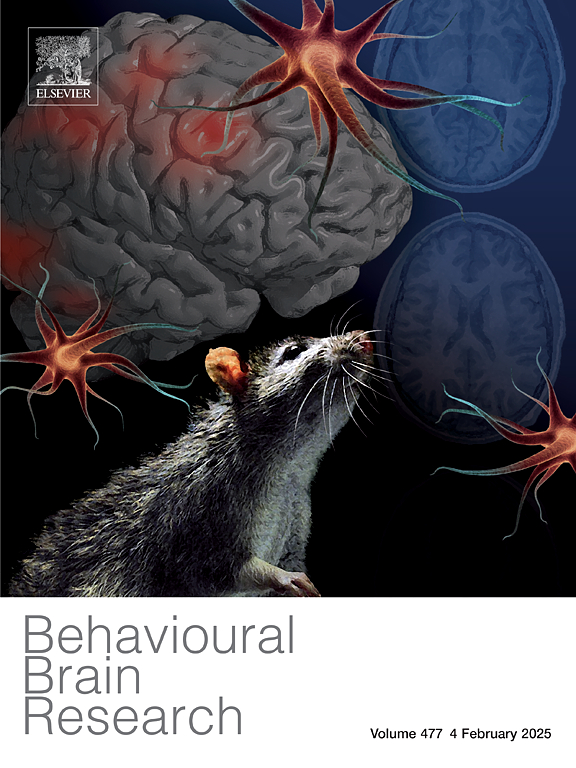左顶叶上皮质结构与认知和双重任务相关:轻度认知障碍与健康对照的横断面初步研究
IF 2.6
3区 心理学
Q2 BEHAVIORAL SCIENCES
引用次数: 0
摘要
背景轻度认知障碍(MCI)个体在认知和双任务范式方面表现较差,但相关的皮质厚度和表面积变化尚不清楚。方法:招募30例轻度认知障碍患者和30例健康对照。采用核磁共振成像、认知能力评估和双任务Timed Up and Go测试(DT-TUG)评估执行时间的大脑皮质厚度和表面积、认知功能和双任务成本(DTC)。采用Spearman相关来评估认知、TUG表现与皮层形态学指标之间的关系。结果:MCI参与者在蒙特利尔认知评估(MoCA)、WAIS数字广度、TMT和改良波斯纳外周提示任务中表现较差。他们在DT-TUG上的执行时间也被延长了。HC组WAIS数字跨度向后与DT-TUG相关。左SPC表面积组间差异显著。HC组该脑区皮质厚度与MoCA总分和注意亚域呈正相关。仅HC组脑皮层厚度和表面积与DT-TUG时间相关。结论:MCI患者表现出认知功能和双任务行走能力的下降。本研究进一步证实了轻度认知损伤患者和非轻度认知损伤患者左SPC的表面结构差异,并支持左SPC在认知和双任务行走中的作用。本文章由计算机程序翻译,如有差异,请以英文原文为准。
Cortical structure of left superior parietal cortex is associated with cognition and dual tasking: A cross-sectional preliminary study between mild cognitive impairment and healthy controls
Background
Individuals with mild cognitive impairment (MCI) exhibit poorer performance in cognition and dual-task paradigm, while the related cortical thickness and surface area alterations remains unclear. Methods: Thirty participants with MCI and thirty healthy controls (HC) were recruited. Magnetic resonance imaging, cognitive assessments and dual-task Timed Up and Go test (DT-TUG) were performed to assess cerebral cortical thickness and surface area, cognitive functions, and dual-task cost (DTC) of the execution time in TUG. Spearman correlations were conducted to assess the relationships between the cognitive, TUG performance with the cortical morphological measures. Results: MCI participants performed worse in the Montreal cognitive assessment (MoCA), WAIS Digit Span, TMT and the modified Posner peripheral cuing task. Their execution time on the DT-TUG was also prolonged. WAIS Digit Span Backwards was correlated with DT-TUG in HC group. A significant between-group difference was observed in the surface area of the left SPC. The cortical thickness of this brain region was positively correlated with the total scores and attention subdomain of MoCA in HC group. The cortical thickness and the surface area were correlated with the time of DT-TUG in HC group only. Conclusions: Individuals with MCI demonstrated declines in both cognitive function and dual-task walking performance. This study provides further evidence of surface-based structural differences in the left SPC in individuals with and without MCI, and supports the role of the left SPC in cognition and dual-task walking.
求助全文
通过发布文献求助,成功后即可免费获取论文全文。
去求助
来源期刊

Behavioural Brain Research
医学-行为科学
CiteScore
5.60
自引率
0.00%
发文量
383
审稿时长
61 days
期刊介绍:
Behavioural Brain Research is an international, interdisciplinary journal dedicated to the publication of articles in the field of behavioural neuroscience, broadly defined. Contributions from the entire range of disciplines that comprise the neurosciences, behavioural sciences or cognitive sciences are appropriate, as long as the goal is to delineate the neural mechanisms underlying behaviour. Thus, studies may range from neurophysiological, neuroanatomical, neurochemical or neuropharmacological analysis of brain-behaviour relations, including the use of molecular genetic or behavioural genetic approaches, to studies that involve the use of brain imaging techniques, to neuroethological studies. Reports of original research, of major methodological advances, or of novel conceptual approaches are all encouraged. The journal will also consider critical reviews on selected topics.
 求助内容:
求助内容: 应助结果提醒方式:
应助结果提醒方式:


